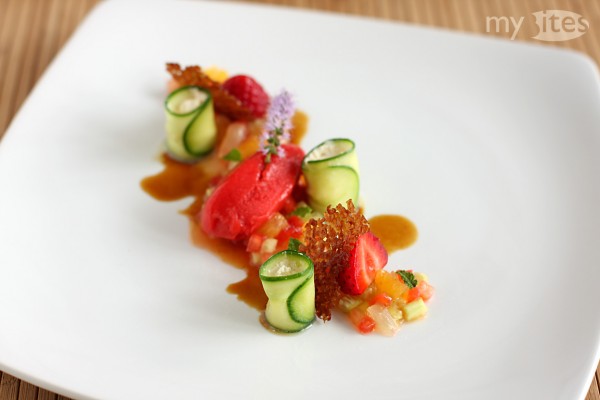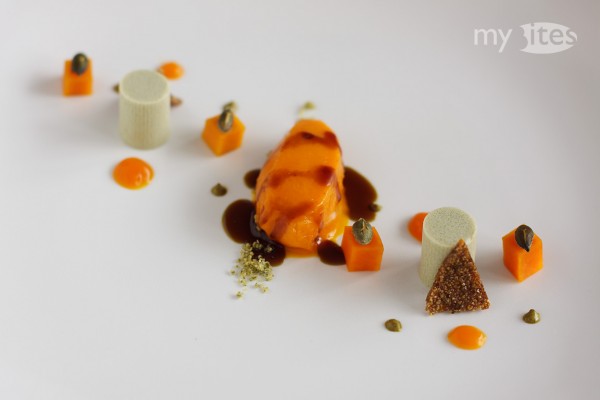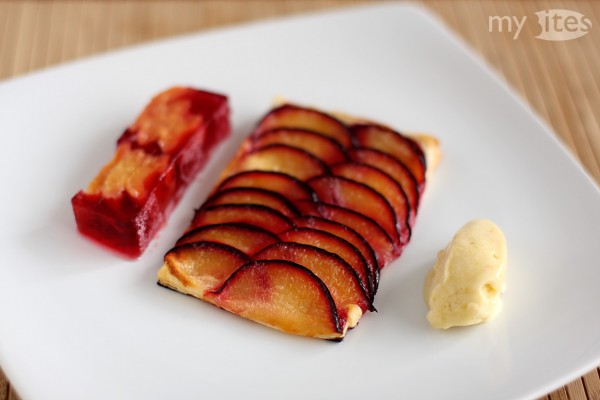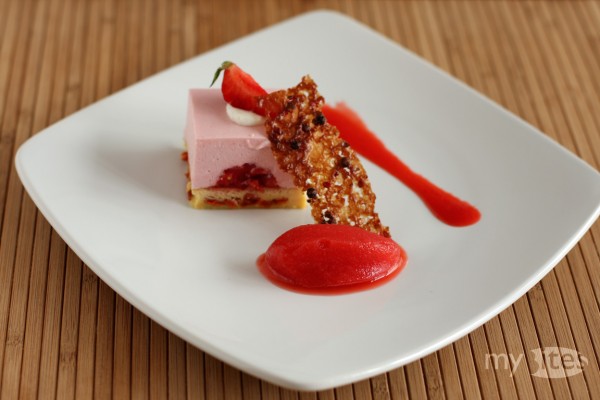Pimm’s & Lemonade is probably the most famous and most popular cocktail of Britain. Its main ingredient is a liqueur called Pimm’s No. 1, which recipe is unchanged – and still kept secret – since 1823, when James Pimm invented and served it as medicine for digestion problems. Pimm’s No. 1 is made with gin, but several other variations exist, like No. 3, which is made with brandy, or No. 6, which is based on vodka. Pimm’s & Lemonade is served in almost every English pub. According to taste it’s usually prepared either with lemonade or with ginger ale. Due to its fresh ingredients – such as strawberries, mint, cucumber, lemon, lime and orange – it is a perfect summer cocktail. While I was thinking about how this combination of ingredients might have developed into the final cocktail, I also thought about transforming Pimm’s & Lemonade (or to be exact in this case: Pimm’s & Ginger Ale) into a plated dessert. After planning each element thoroughly, I ended up with this colorful and extremely refreshing summer dessert.
Tag Archives: sorbet
Butternut Squash with Pumpkin Seeds
Thinking about vegan desserts it was surprising to me how much our usual desserts rely on animal products. Many – if not most – recipes contain either eggs, gelatin, butter, milk, cream or honey. Sometimes not even fruit sorbets are pure because adding some egg white or mascarpone makes their texture less crystalline. On the other hand, many animal products can be substituted: Instead of milk or cream you can create nutritious milk from rice or nuts. In many cases, butter can be substituted by flavorful vegetable oils. Honey too can be replaced by various natural sweeteners such as sugar beet molasses, agave or rice syrup. I believe that all these great plant-based products should not be treated as substitutions only, but rather as full-valued products. If we would stop thinking of them as substitutions and rather see them as full-valued ingredients, many new and creative desserts could be created.
Plum Variations
In autumn plums appear at the markets in various sizes, colors and shapes. For example the round ones are pretty close to nectarines, with the only visual difference that their skins are blue or pale yellow. The oval damsons are the most common here in Franconia, in most cases this is the plum you will find at all markets. And sometimes, if you’re lucky, you might even spot some tiny greengages. Removing their seeds makes the most work among these three plums, but greengages also have a very nice wild, more natural taste. For this dessert I combined these three plum subspecies, all with interesting added flavorings.
Peach and Almond Toffee Tart with Fennel Sorbet
Recently vegetables are becoming more and more popular as dessert ingredients. I don’t think it’s so unusual to use vegetables in desserts, because a lot of them are already pretty sweet on their own. Carrots, pumpkins or zucchinis became quite common as cake ingredients recently. Fennel for example can be applied in desserts too. The anise flavor has already been used for several hundred years as a spice for sweets. Combined with white wine, fennel makes a very nice sorbet, which can be paired perfectly with almond and peach, e.g. like with this delicious tart.
The Pink Dessert
The final dish of my meatless menu for the 2011 ZEITmagazin cooking competition is a variation of strawberry. I usually make the cake using rhubarb instead of strawberry and yoghurt for the mousse, but unfortunately the rhubarb season was already over when the competition was held. Because Goji-berries are about the same size as raisins, I used them similarly by soaking them in rum and adding them afterwards to the sponge cake base. Already in the cake alone there are three variations of strawberry present: diced and orange liquer marinated strawberry pieces, a light strawberry-yoghurt mousse and a quarter of raw strawberry at the top.




